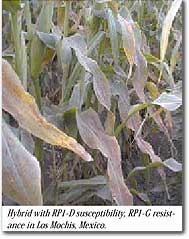| In September 2000, isolates of P. sorghi with the same
pattern of virulence as the new race in North America were collected from sweet
corn growing in the Andes and Pyrénées Atlantiques department of the Aquitaine
region of southwestern France.
Like in some parts of the US, the rust population
in France was predominantly the old, avirulent race. Rust severity was generally
below 5% on hybrids with the Rp1-D gene except for a few Rp1-D-resistant
hybrids for which rust severity was about 20% to 30%.
In late-August and September 2000, isolates of rust with
virulence against many of the other Rp genes were collected in Urbana, IL.
Some
isolates were virulent (susceptible reaction) against the Rp1-E, Rp1-I
and Rp1-K genes but avirulent (resistant reaction) against the Rp1-D
gene. Others were virulent against the Rp-G gene but avirulent
against Rp1-D.
None of the isolates were virulent against all of the Rp
genes nor were any of them very common (i.e., rust severity on Rp-resistant
lines was less than 5%). |
Prospects for 2001 and the future
It will be difficult to predict the reactions of Rp-resistant
hybrids in 2001 or for the next few years because virulence in P. sorghi
populations probably will vary much like they did in 2000. Hybrids with
Rp-resistance will be completely effective if virulence is absent. They will
provide moderate levels of control if virulent isolates are merely a small
proportion of the rust population. They will be ineffective if virulent isolates
are abundant. The background reactions of Rp-resistant hybrids will determine
how severe rust becomes when these hybrid are infected by virulent isolates of
P. sorghi.

|